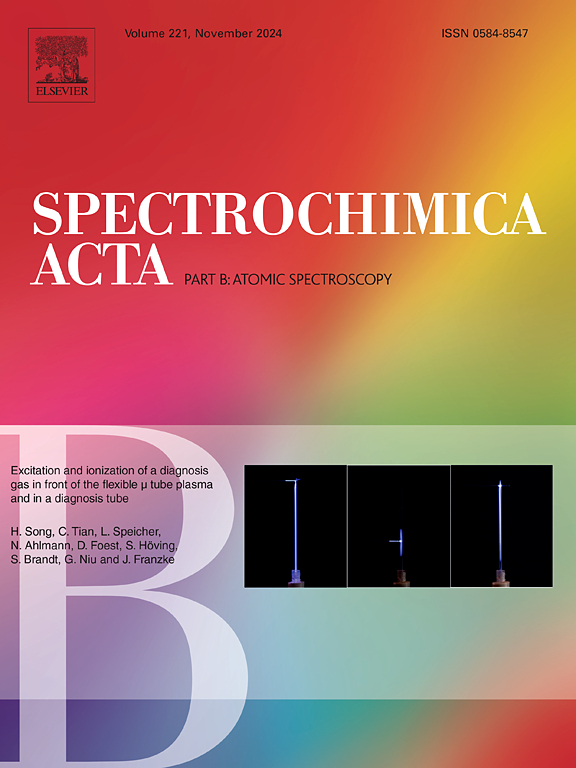Fate of laser-induced plasma material: Particle formation and re-deposition effects in micro-LIBS scanning applications
IF 3.8
2区 化学
Q1 SPECTROSCOPY
引用次数: 0
Abstract
This paper aims to investigate the fate of ablated material during LIBS imaging and assess the potential impact of re-deposited material on the sample's elemental quantification. A standard brass alloy (80/20 % Cu/Zn) embedded in pure epoxy resin was used as the sample for this study. The particles produced during the LIBS imaging experiment were collected over a large area, spanning several millimeters, and analyzed using High-Resolution Optical Microscopy and Scanning Electron Microscopy. Time-resolved Laser-Induced Plasma images were utilized to interpret the particles distribution, revealing two distinct groups —nanoparticles and microparticles—after plasma extinction. Based on these observations, the effects of plasma condensation, plasma charging, and shockwave transport on the ablated material are discussed. Finally, the impact of re-deposited particles on elemental analysis during LIBS imaging is critically examined.

激光诱导等离子体材料的命运:微libs扫描应用中的粒子形成和再沉积效应
本文旨在研究烧蚀材料在LIBS成像过程中的命运,并评估再沉积材料对样品元素定量的潜在影响。本研究采用纯环氧树脂包埋标准黄铜合金(80/ 20% Cu/Zn)作为样品。在LIBS成像实验中产生的颗粒被收集在一个大范围内,跨越几毫米,并使用高分辨率光学显微镜和扫描电子显微镜进行分析。时间分辨激光诱导等离子体图像用来解释粒子分布,揭示两种不同的组-纳米粒子和微粒-等离子体消光后。在此基础上,讨论了等离子体凝聚、等离子体充电和冲击波输运对烧蚀材料的影响。最后,重沉积颗粒对LIBS成像期间元素分析的影响进行了严格检查。
本文章由计算机程序翻译,如有差异,请以英文原文为准。
求助全文
约1分钟内获得全文
求助全文
来源期刊
CiteScore
6.10
自引率
12.10%
发文量
173
审稿时长
81 days
期刊介绍:
Spectrochimica Acta Part B: Atomic Spectroscopy, is intended for the rapid publication of both original work and reviews in the following fields:
Atomic Emission (AES), Atomic Absorption (AAS) and Atomic Fluorescence (AFS) spectroscopy;
Mass Spectrometry (MS) for inorganic analysis covering Spark Source (SS-MS), Inductively Coupled Plasma (ICP-MS), Glow Discharge (GD-MS), and Secondary Ion Mass Spectrometry (SIMS).
Laser induced atomic spectroscopy for inorganic analysis, including non-linear optical laser spectroscopy, covering Laser Enhanced Ionization (LEI), Laser Induced Fluorescence (LIF), Resonance Ionization Spectroscopy (RIS) and Resonance Ionization Mass Spectrometry (RIMS); Laser Induced Breakdown Spectroscopy (LIBS); Cavity Ringdown Spectroscopy (CRDS), Laser Ablation Inductively Coupled Plasma Atomic Emission Spectroscopy (LA-ICP-AES) and Laser Ablation Inductively Coupled Plasma Mass Spectrometry (LA-ICP-MS).
X-ray spectrometry, X-ray Optics and Microanalysis, including X-ray fluorescence spectrometry (XRF) and related techniques, in particular Total-reflection X-ray Fluorescence Spectrometry (TXRF), and Synchrotron Radiation-excited Total reflection XRF (SR-TXRF).
Manuscripts dealing with (i) fundamentals, (ii) methodology development, (iii)instrumentation, and (iv) applications, can be submitted for publication.

 求助内容:
求助内容: 应助结果提醒方式:
应助结果提醒方式:


